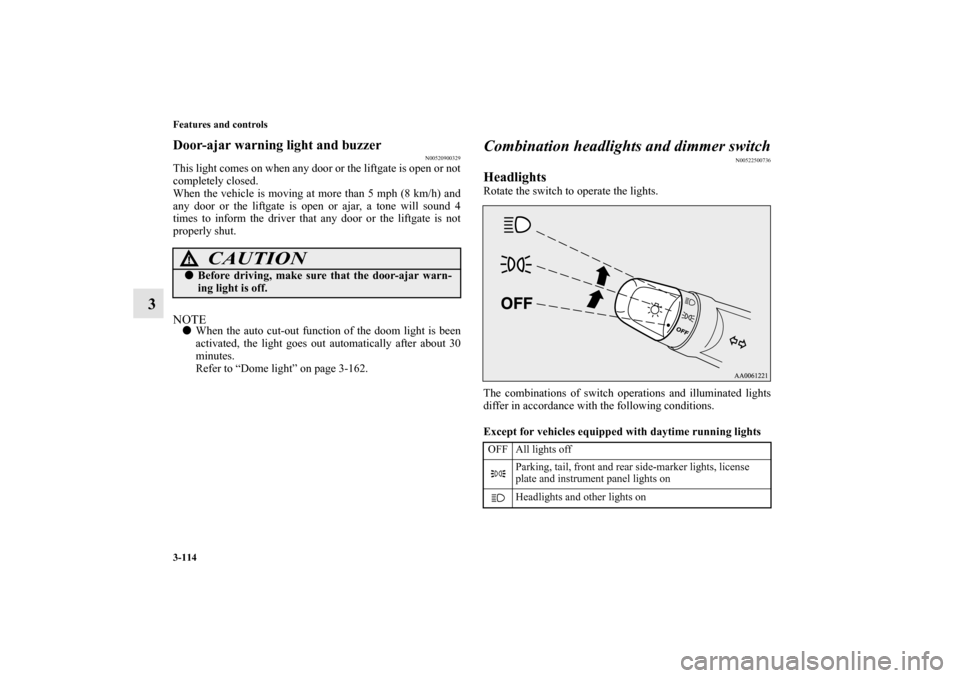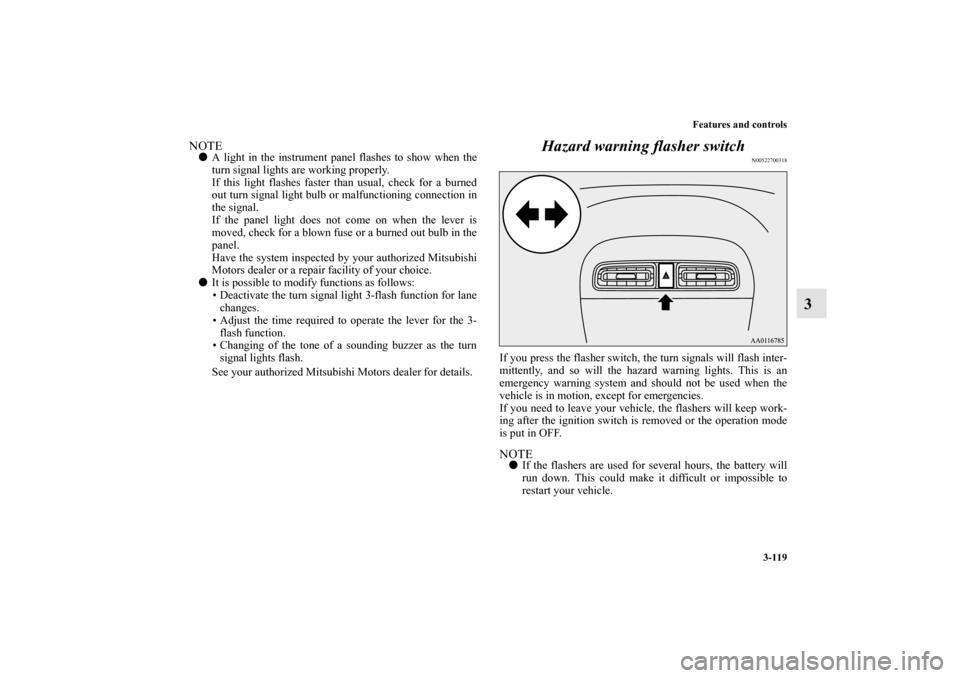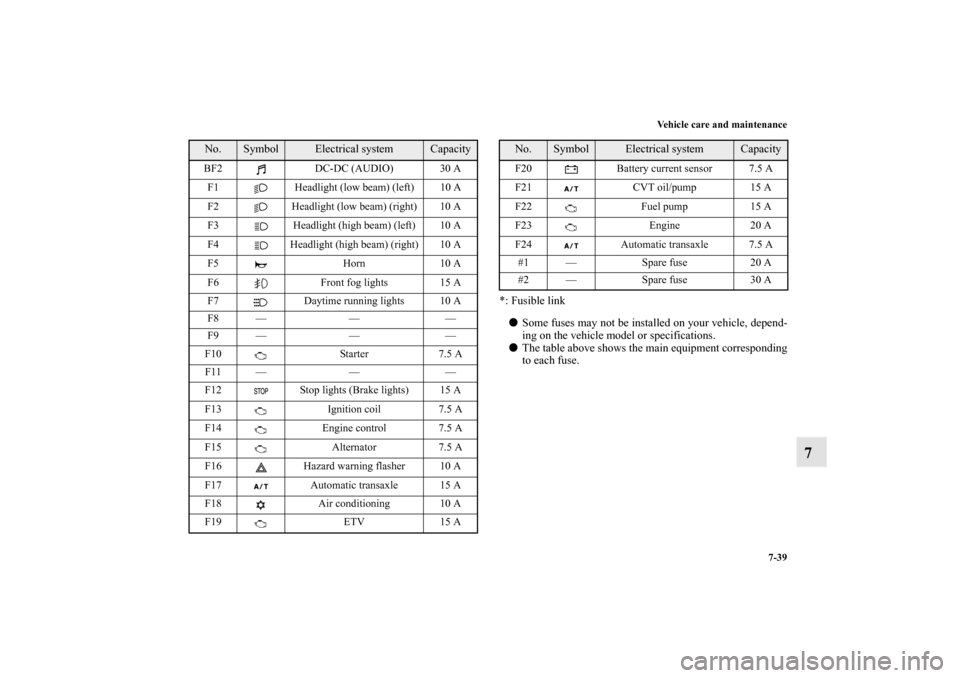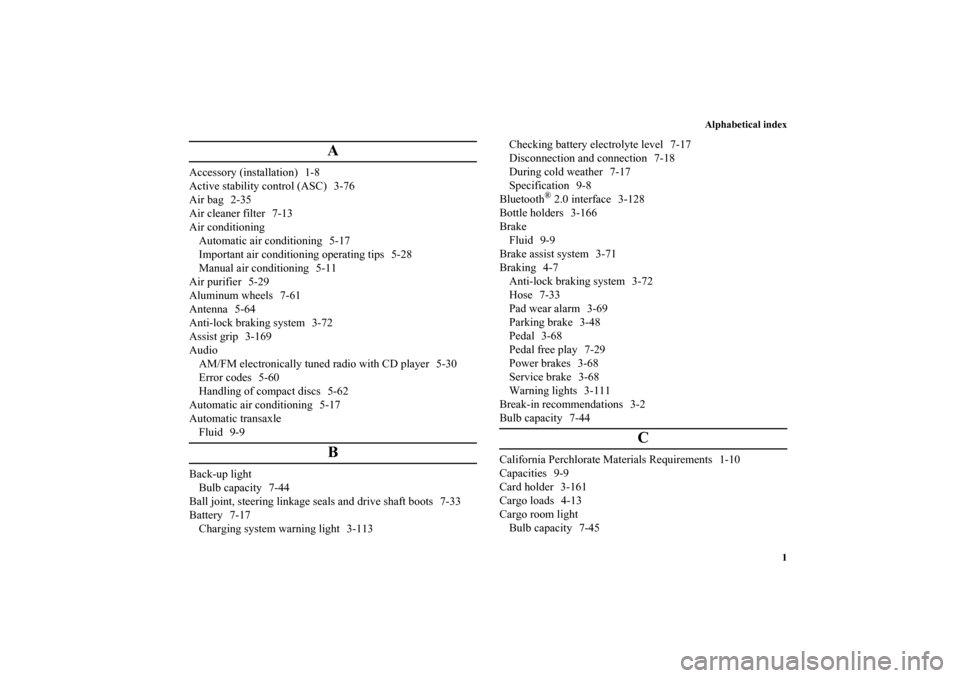Page 202 of 460

3-114 Features and controls
3
Door-ajar warning light and buzzer
N00520900329
This light comes on when any door or the liftgate is open or not
completely closed.
When the vehicle is moving at more than 5 mph (8 km/h) and
any door or the liftgate is open or ajar, a tone will sound 4
times to inform the driver that any door or the liftgate is not
properly shut.NOTE�When the auto cut-out function of the doom light is been
activated, the light goes out automatically after about 30
minutes.
Refer to “Dome light” on page 3-162.
Combination headlights and dimmer switch
N00522500736
HeadlightsRotate the switch to operate the lights.
The combinations of switch operations and illuminated lights
differ in accordance with the following conditions.
Except for vehicles equipped with daytime running lights
CAUTION
!�Before driving, make sure that the door-ajar warn-
ing light is off.
OFF All lights off
Parking, tail, front and rear side-marker lights, license
plate and instrument panel lights on
Headlights and other lights on
BK0162600US.book 114 ページ 2013年3月22日 金曜日 午後2時41分
Page 207 of 460

Features and controls
3-119
3
NOTE�A light in the instrument panel flashes to show when the
turn signal lights are working properly.
If this light flashes faster than usual, check for a burned
out turn signal light bulb or malfunctioning connection in
the signal.
If the panel light does not come on when the lever is
moved, check for a blown fuse or a burned out bulb in the
panel.
Have the system inspected by your authorized Mitsubishi
Motors dealer or a repair facility of your choice.
�It is possible to modify functions as follows:
• Deactivate the turn signal light 3-flash function for lane
changes.
• Adjust the time required to operate the lever for the 3-
flash function.
• Changing of the tone of a sounding buzzer as the turn
signal lights flash.
See your authorized Mitsubishi Motors dealer for details.
Hazard warning flasher switch
N00522700318
If you press the flasher switch, the turn signals will flash inter-
mittently, and so will the hazard warning lights. This is an
emergency warning system and should not be used when the
vehicle is in motion, except for emergencies.
If you need to leave your vehicle, the flashers will keep work-
ing after the ignition switch is removed or the operation mode
is put in OFF.NOTE�If the flashers are used for several hours, the battery will
run down. This could make it difficult or impossible to
restart your vehicle.
BK0162600US.book 119 ページ 2013年3月22日 金曜日 午後2時41分
Page 342 of 460

6-2 For emergencies
6If the vehicle breaks down
N00836300233
If your vehicle breaks down on the road, move to the shoulder
and turn on the hazard warning flashers. If there is no shoulder,
or the shoulder is not safe, drive in the right lane slowly with
the hazard lights flashing until you come to a safe stopping
place. Keep the flashers flashing.If the engine stops/failsIf the engine stops, there will be no power assist to the steering
and brakes, making these difficult to use.
�The brake booster will not work, so the brakes will not
grip well. The brake pedal will be harder to press than
usual.
�Since there is no power steering assist, the steering wheel
will be hard to turn.When the engine fails at the intersectionGet help from your passengers, bystanders, etc. to push the
vehicle and move it to a safe area.
Jump-starting the engine
N00836400768
If the engine cannot be started because the battery is weak or
dead, you can start it with the battery from another vehicle
using jumper cables.NOTE�Do not use jumper cables if they have damage or corro-
sion.
1. Take off any metal jewelry such as watch bands or brace-
lets that might create an accidental electrical contact.
2. Position the vehicles close enough together so that the
jumper cables can reach, but be sure the vehicles aren’t
touching each other.
WA R N I N G
!�To reduce the risk of igniting flammable gas that
may be emitted from the battery, carefully read this
section before jump-starting the vehicle.�Do not try to start your vehicle by pushing or tow-
ing. This can cause an accident resulting in serious
injury or death and can damage the vehicle.
CAUTION
!�Check the other vehicle. It must have a 12-volt bat-
tery. If the other system isn’t 12-volt, both systems
can be damaged.
BK0162600US.book 2 ページ 2013年3月22日 金曜日 午後2時41分
Page 345 of 460

For emergencies
6-5
6
As your vehicle has anti-lock brakesIf you drive your vehicle with a low battery charge after the
engine has been started by using jumper cables, the engine may
misfire. This can cause the anti-lock braking system warning
light to blink on and off. This is only due to the low battery
voltage. It is not a problem with the brake system. If this hap-
pens, fully charge the battery and ensure the charging system is
operating properly.
Engine overheating
N00836500365
If the high coolant temperature warning light illuminates dur-
ing the engine is running, the engine may be overheating. If
this happens:
1. Stop the vehicle in a safe place. Turn on the hazard warn-
ing flashers.
2. With the engine still running, carefully raise the engine
hood to vent the engine compartment.
3. Check that the cooling fan is running. If the fan is not
turning, stop the engine immediately and contact an
authorized Mitsubishi Motors dealer or a repair facility of
your choice for assistance.
4. If you see steam or spray coming from under the hood,
turn off the engine.
WA R N I N G
!�To avoid personal injury, keep hands, hair, jewelry
and clothes away from the cooling fan. The cooling
fan can start at any time.
BK0162600US.book 5 ページ 2013年3月22日 金曜日 午後2時41分
Page 346 of 460

6-6 For emergencies
6
5. If you do not see steam or spray coming from under the
hood, leave the engine on until the high coolant tempera-
ture warning light goes off. After the high coolant temper-
ature warning light has gone off, you can start driving
again. If the high coolant temperature warning light stays
on, turn off the engine.
6. When you do not see any more steam or spray, open the
hood. Look for obvious leaks, such as a split radiator
hose. Be careful as components will be hot. Any leak
source must be repaired.
7. If there is no obvious leak source, check the coolant level
in the engine coolant reserve tank. If there is none, or if it
is too low, slowly add coolant.8. If the engine coolant reserve tank needs coolant, you will
probably also need to add coolant to the radiator. Do not
loosen or remove the radiator cap until the engine has
cooled down.
9. Start the engine, and slowly add coolant, up to the bottom
of the filler neck. Use plain water if you have to (and
replace it with the right coolant as soon as possible).
10. Replace the radiator cap and tighten it fully. Check the
coolant temperature warning light. You can start driving
again when the high coolant temperature warning light
does not come on.
11. Have the system inspected by your authorized Mitsubishi
Motors dealer or a repair facility of your choice.
WA R N I N G
!�Before raising the engine hood, check to see if there
is steam or spray coming from under the hood.
Steam or spray coming from an overheated engine
could seriously scald you.
Do not open the hood until there is no steam or
spray.
WA R N I N G
!�Removing the radiator cap could scald you with
escaping hot water or steam. When checking the
radiator level, cover the cap with a cloth before try-
ing to remove it. Turn it slowly counterclockwise,
without pressing down, to the first notch. The pres-
sure in the system will then be let out. When the
pressure is COMPLETELY LET OUT, press down
and keep turning the cap counterclockwise until it
comes off.
BK0162600US.book 6 ページ 2013年3月22日 金曜日 午後2時41分
Page 358 of 460

6-18 For emergencies
6How to change a tire (Vehicles equipped
with spare tire)
N00836900819
Before changing a tire, first stop your vehicle in a safe, flat
location.
1. Park the vehicle on level and stable ground.
2. Set the parking brake firmly.
3. On vehicles equipped with manual transaxle, stop the
engine and move the gearshift lever to the “R” (Reverse)
position.
On vehicles equipped with continuously variable trans-
mission (CVT), move the selector lever to the “P”
(PARK) position, and stop the engine.
4. Turn on the hazard flashers and set up a warning triangle,
flashing signal light, etc., at an adequate distance from the
vehicle, and have all your passengers exit the vehicle.5. To prevent the vehicle from rolling when it is raised on the
jack, place chocks or blocks (A) at the tire that is diago-
nally opposite from the tire (B) you are changing.
WA R N I N G
!�The jack should not be used for any purpose other
than to change a tire.�Never get under the vehicle or put any portion of
your body under the vehicle while it is supported by
the jack.
BK0162600US.book 18 ページ 2013年3月22日 金曜日 午後2時41分
Page 413 of 460

Vehicle care and maintenance
7-39
7
*: Fusible link
�Some fuses may not be installed on your vehicle, depend-
ing on the vehicle model or specifications.
�The table above shows the main equipment corresponding
to each fuse.
BF2 DC-DC (AUDIO) 30 A
F1 Headlight (low beam) (left) 10 A
F2 Headlight (low beam) (right) 10 A
F3 Headlight (high beam) (left) 10 A
F4 Headlight (high beam) (right) 10 A
F5 Horn 10 A
F6 Front fog lights 15 A
F7 Daytime running lights 10 A
F8 — — —
F9 — — —
F10 Starter 7.5 A
F11 — — —
F12 Stop lights (Brake lights) 15 A
F13 Ignition coil 7.5 A
F14 Engine control 7.5 A
F15 Alternator 7.5 A
F16 Hazard warning flasher 10 A
F17 Automatic transaxle 15 A
F18 Air conditioning 10 A
F19 ETV 15 ANo.
Symbol
Electrical system
Capacity
F20 Battery current sensor 7.5 A
F21 CVT oil/pump 15 A
F22 Fuel pump 15 A
F23 Engine 20 A
F24 Automatic transaxle 7.5 A
#1 — Spare fuse 20 A
#2 — Spare fuse 30 ANo.
Symbol
Electrical system
Capacity
BK0162600US.book 39 ページ 2013年3月22日 金曜日 午後2時41分
Page 453 of 460

Alphabetical index
1
A
Accessory (installation) 1-8
Active stability control (ASC) 3-76
Air bag 2-35
Air cleaner filter 7-13
Air conditioning
Automatic air conditioning 5-17
Important air conditioning operating tips 5-28
Manual air conditioning 5-11
Air purifier 5-29
Aluminum wheels 7-61
Antenna 5-64
Anti-lock braking system 3-72
Assist grip 3-169
Audio
AM/FM electronically tuned radio with CD player 5-30
Error codes 5-60
Handling of compact discs 5-62
Automatic air conditioning 5-17
Automatic transaxle
Fluid 9-9
B
Back-up light
Bulb capacity 7-44
Ball joint, steering linkage seals and drive shaft boots 7-33
Battery 7-17
Charging system warning light 3-113Checking battery electrolyte level 7-17
Disconnection and connection 7-18
During cold weather 7-17
Specification 9-8
Bluetooth
® 2.0 interface 3-128
Bottle holders 3-166
Brake
Fluid 9-9
Brake assist system 3-71
Braking 4-7
Anti-lock braking system 3-72
Hose 7-33
Pad wear alarm 3-69
Parking brake 3-48
Pedal 3-68
Pedal free play 7-29
Power brakes 3-68
Service brake 3-68
Warning lights 3-111
Break-in recommendations 3-2
Bulb capacity 7-44
C
California Perchlorate Materials Requirements 1-10
Capacities 9-9
Card holder 3-161
Cargo loads 4-13
Cargo room light
Bulb capacity 7-45
BK0162600US.book 1 ページ 2013年3月22日 金曜日 午後2時41分